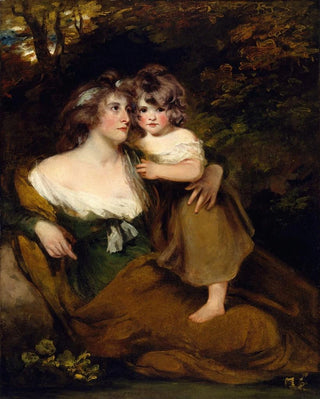Art print | The Countess of Darnley and her daughter Lady Elizabeth Bligh - John Hoppner


View from behind

Frame (optional)
In the vast panorama of British art history, the artwork "The Countess of Darnley and her daughter Lady Elizabeth Bligh" by John Hoppner stands out for its elegance and psychological depth. This painting, created at the end of the 18th century, captures not only the beauty of the subjects but also an intimate moment, revealing family relationships and social dynamics of the time. Hoppner, a renowned portraitist, infused his works with an atmosphere of refinement and delicacy, making this piece a true window into the past. Contemplating this artwork, the viewer is transported to a universe where nobility is allied with subtle humanity, offering a rich and emotional visual experience.
Style and uniqueness of the work
John Hoppner's style is characterized by an exceptional mastery of light and shadow play, as well as meticulous attention to detail. In "The Countess of Darnley and her daughter Lady Elizabeth Bligh," the faces of the two women are illuminated with an almost ethereal softness, highlighting their delicate features and serene expressions. The drapery of the clothing, rendered with remarkable precision, demonstrates a craftsmanship that transcends simple portraiture to become a true study of texture and movement. The composition, carefully balanced, guides the viewer's gaze toward the faces while subtly integrating surrounding elements that enrich the painting. Thus, Hoppner manages to create a visual harmony that captures attention and invites prolonged contemplation.
The artist and his influence
John Hoppner, born in 1758, is one of the most prominent portraitists of his era. Trained under the influence of the neoclassical school, he evolved toward a more romantic style, incorporating elements of realism and emotion into his portraits. His career was marked by numerous commissions from the British high society, which allowed him to build a solid reputation. Hoppner not only influenced his contemporaries but also left a lasting legacy in the world of

Matte finish

View from behind

Frame (optional)
In the vast panorama of British art history, the artwork "The Countess of Darnley and her daughter Lady Elizabeth Bligh" by John Hoppner stands out for its elegance and psychological depth. This painting, created at the end of the 18th century, captures not only the beauty of the subjects but also an intimate moment, revealing family relationships and social dynamics of the time. Hoppner, a renowned portraitist, infused his works with an atmosphere of refinement and delicacy, making this piece a true window into the past. Contemplating this artwork, the viewer is transported to a universe where nobility is allied with subtle humanity, offering a rich and emotional visual experience.
Style and uniqueness of the work
John Hoppner's style is characterized by an exceptional mastery of light and shadow play, as well as meticulous attention to detail. In "The Countess of Darnley and her daughter Lady Elizabeth Bligh," the faces of the two women are illuminated with an almost ethereal softness, highlighting their delicate features and serene expressions. The drapery of the clothing, rendered with remarkable precision, demonstrates a craftsmanship that transcends simple portraiture to become a true study of texture and movement. The composition, carefully balanced, guides the viewer's gaze toward the faces while subtly integrating surrounding elements that enrich the painting. Thus, Hoppner manages to create a visual harmony that captures attention and invites prolonged contemplation.
The artist and his influence
John Hoppner, born in 1758, is one of the most prominent portraitists of his era. Trained under the influence of the neoclassical school, he evolved toward a more romantic style, incorporating elements of realism and emotion into his portraits. His career was marked by numerous commissions from the British high society, which allowed him to build a solid reputation. Hoppner not only influenced his contemporaries but also left a lasting legacy in the world of






